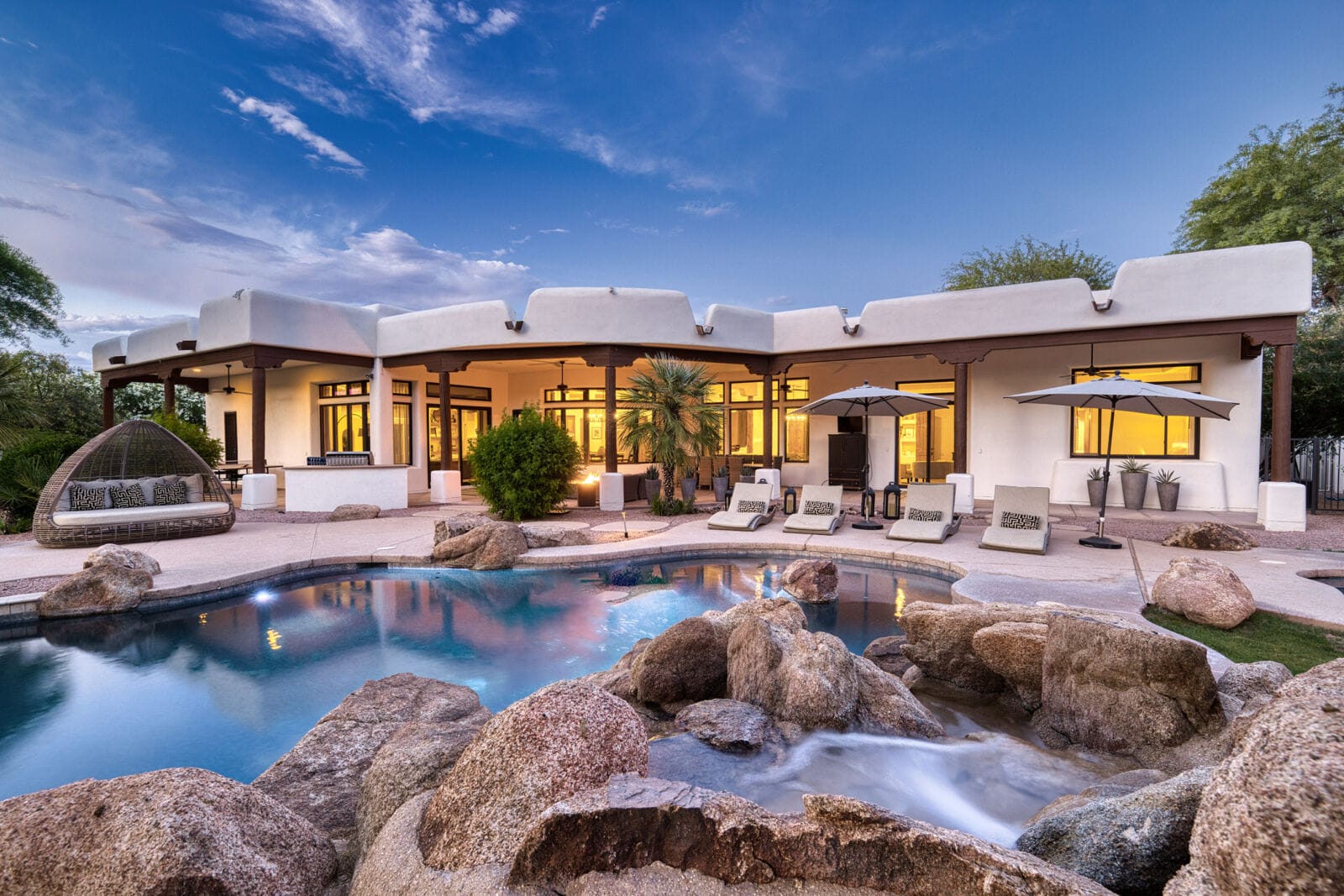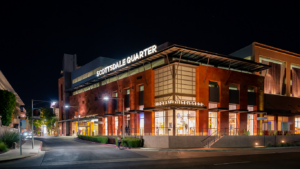Arizona’s luxury real estate market is experiencing a sustained boom, especially in elite neighborhoods like Scottsdale and Paradise Valley, and expanding upscale zones in Gilbert and North Phoenix. As of early 2025, these areas are drawing high-net-worth individuals with promises of privacy, tax advantages, premium amenities, and access to outdoor and wellness-oriented lifestyles.
MORE NEWS: Arizona economy keeps rolling: Here are the numbers
WANT MORE ECONOMIC INSIGHTS? Get our free newsletter here
According to Redfin’s February 2025 report, the median home sale price in Maricopa County reached USD 495,000, reflecting a 4.2 percent annual increase. However, the luxury segment—homes over USD 1.5 million—has grown faster, with ultra-luxury properties in Paradise Valley regularly listing above USD 10 million.
This expansion reflects both economic prosperity and demographic shifts. However, it also deepens concerns about affordability, gentrification, and long-term community balance. Would-be buyers, investors, and current luxury homeowners need to understand the underlying causes of the luxury housing surge and its implications for the broader Arizona real estate market.
Factors Fueling the Luxury Home Sales Surge
Arizona’s luxury home boom is driven by several factors, including:
1. Infrastructure Development and Accessibility
Arizona’s luxury real estate surge is closely tied to the region’s ongoing infrastructure enhancements, significantly improving accessibility to upscale neighborhoods. Key projects such as the Loop 101 widening through Scottsdale, ongoing upgrades to Phoenix Sky Harbor International Airport, and transportation expansions in Gilbert and Mesa make luxury corridors more convenient for high-income residents and out-of-state investors.
While specific countywide spending figures for capital projects are not centrally published, recent insights from Maricopa County’s FY2023 budget summary show that the county spent approximately $87 per resident on capital projects—well below national averages for counties of comparable size. This spending includes strategic investments in roads, bridges, and flood control infrastructure, directly supporting the growth of high-end residential zones.
Moreover, municipalities like Scottsdale and Gilbert have adopted ambitious Capital Improvement Plans (CIPs) through 2023, focusing on long-term infrastructure resilience and mobility upgrades to accommodate population and market growth. These infrastructure commitments continue to elevate the desirability of Arizona’s luxury housing market, reinforcing the region’s reputation as an ideal destination for affluent buyers seeking both convenience and quality of life.
2. Arizona’s Economic Growth and Appeal to Affluent Buyers
Arizona continues positioning itself as a rising economic powerhouse in the U.S. Southwest, thanks to strategic investments in high-growth industries. While precise GDP growth figures for 2023 are not officially published, the Arizona Commerce Authority confirms that the state has achieved record-breaking economic development milestones, particularly in advanced manufacturing, semiconductors, biosciences, and financial services.
Arizona has attracted over USD 105 billion in private-sector investment since 2020, with semiconductor giants like TSMC, Intel, and Amkor expanding operations in the Phoenix metro area. These high-wage sectors generate sustained demand for executive-level housing and premium residences in luxury enclaves such as North Scottsdale, Silverleaf, and Paradise Valley.
In parallel, Arizona has become a top destination for remote workers and relocating high-income individuals, especially from states like California, Illinois, and New York. Moreover, the state ranked fifth nationally for remote work relocation, welcoming approximately 282,000 new residents in 2022 alone. Arizona’s business-friendly climate, lower tax burden, and abundant luxury housing options draw many transplants.
These intersecting forces—economic diversification and lifestyle-driven migration—are fueling ongoing momentum in Arizona’s high-end real estate sector.
3. In-Migration of High-Income Residents
Arizona continues to attract a growing number of high-income transplants, drawn by the state’s favorable tax environment, affordable cost of living relative to coastal markets, and high-quality lifestyle. The latest figures show that Arizona’s population grew by approximately 1.29 percent between 2022 and 2023, pushing the state’s population past 7.47 million.
Migration has been robust in the Phoenix metro area, which added nearly 85,000 new residents in 2024. While much of this growth is supported by international migration and workforce expansion, Arizona remains among the top destinations for domestic relocations, especially from high-cost states like California, Illinois, and New York.
Many of these incoming residents are high-income earners or remote professionals looking for residences that offer privacy, exclusivity, and scenic surroundings. The demand is robust for properties that feature custom architectural design, panoramic desert or mountain views, secure gated access, and access to resort-style amenities. These features are now standard expectations in Arizona’s luxury market.
In particular, Scottsdale and surrounding areas have become premier destinations for affluent buyers. Scottsdale ranks among the top wealth migration hubs in the western United States, compared to Jackson Hole’s appeal.
Gentrification and Changing Community Dynamics
As Arizona’s luxury housing market continues to expand, the effects of redevelopment are increasingly visible in older urban neighborhoods across Central Phoenix, including areas like Arcadia, Coronado, and Willo.
Many of these neighborhoods, once known for their mid-century architecture and modest single-family homes, are now experiencing a wave of tear-downs and luxury rebuilds. This redevelopment trend is transforming the visual and economic character of these communities.
Although precise figures on rising property taxes in these neighborhoods are not publicly available, the broader trend reflects increasing concerns over gentrification-related displacement. The Morrison Institute for Public Policy highlights that limited affordable housing supply, exclusionary zoning, and community resistance to higher-density housing are key barriers to equitable growth in Arizona.
These dynamics often lead to indirect affordability challenges. As property values increase due to redevelopment, property tax assessments and cost-of-living pressures follow suit—placing a disproportionate burden on long-time residents, fixed-income households, and small local businesses. While this revitalization can improve infrastructure and neighborhood appeal, it raises important questions about community preservation and inclusivity.
To ensure Arizona’s urban redevelopment benefits a broad spectrum of residents, experts and policymakers call for more balanced planning approaches—including protections for vulnerable populations and more significant investment in mixed-income housing options. Doing so is essential to maintaining the social and economic diversity that gives these neighborhoods distinctive character.
Investor Considerations: Arizona LLCs and Tax Strategy
Arizona is a popular destination for real estate investors thanks to its favorable, business-friendly tax environment and relative ease of LLC formation. Buying luxury real estate through a Limited Liability Company (LLC) provides asset protection, privacy, and tax benefits.
Those looking for the best state to start an LLC in USA must do their homework to understand the benefits of moving to Arizona and possibly investing in luxury properties through an LLC.
Investors can refer to trusted sources like LLC University and the Arizona Corporation Commission for guidance on structuring LLCs, purchases, and protecting real estate holdings.
Managing Growth While Preserving Community
Arizona’s luxury real estate market has rapidly expanded thanks to economic strength, infrastructure investments, and migration from high-income states. The state’s climate, lifestyle, and tax advantages make it an attractive hub for wealth creation and real estate appreciation.
However, this growth brings mounting pressure on housing affordability, community composition, and public infrastructure. The imbalance between luxury development and inclusive housing access could limit long-term sustainability if left unchecked.
To preserve Arizona’s vibrancy and diversity, policymakers, developers, and investors must work toward a housing strategy that balances premium market opportunities with inclusive growth. Encouraging mixed-income developments, preserving affordable housing stock, and introducing incentives for community-based investments can ensure that the benefits of this real estate boom are widely shared.




